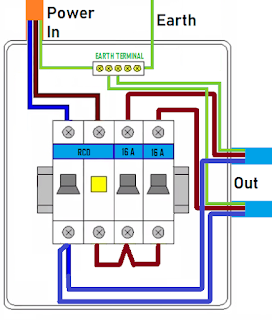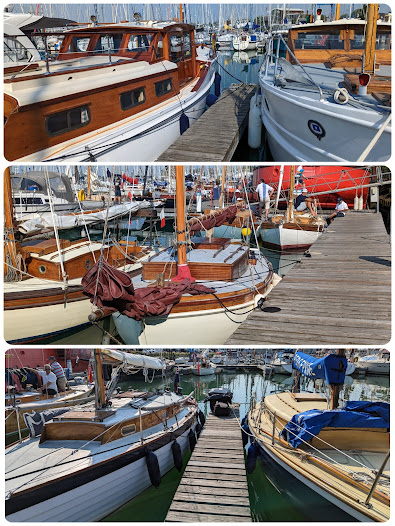Rewiring the mains power
Messing around with mains electricity is not for the faint hearted, add in an environment that is surrounded by water and if you're not careful and competent you have a recipe for disaster!
Finally there was a break in the uk's lock down restrictions as a result of Covid-19, so I could begin prep work for replacing the engine on Isosceles. Stripping out the old mains electrical system was the first job on my list. Although not directly linked to the engine work it would make access easier, and needed to be changed anyway.
 |
| Solid core mains cable, a fire hazard in the long term on a boat. |
 |
| Flexible mains cable is much more tolerant of movement and vibrations on a boat. |
Luckily he hadn't put this on the survey so I had been able to wait before starting to replace the wiring. Now, with the engine about to come out I decided to rewire and move the power distribution / breaker box from inside the engine compartment.
Some people have a fear of working these systems, and I would say if you are not totally sure of what you are doing then you really should seek professional advice. I have always been able to turn my hand to these kinds of jobs, and have had some excellent teachers over the years, including both my father and my former father-in-law who was, and still is for those who are willing to learn, a fount of knowledge of all kinds of practical jobs. Also, do not be afraid to get your work checked. Safety in these systems is paramount.
Planning the electrical system
I have a very simple approach to the electrical system on Isosceles, if it won't run off 12 volt, preferably via a car type adaptor or USB adaptor that plugs in to 12 volt, then I look for something else that will work this way. The only things that regularly use mains when I'm on shore power are the built in battery charger, water heater and a kettle. I have a couple of spare sockets if they are ever needed though.
I decided to move the distribution panel to under the companion way steps. This sounds exposed, but on the moody 37 this is set back about 18 or more inches under the cockpit, and so is protected from the elements. Even so I decided to go for a protected IP67 distribution box.
As the original power input into the boat was over 30 years old and brittle I decided to replace everything from beginning to end.
Isolating the boat
When you connect your boat to a marina electrical supply you also connect your boat to all the other boats in the marina via the earth connection in your shore power mains lead. This creates a pathway for small electrical currents to flow from one boat to another.
Unfortunately this pathway leads to increased corrosion of the underwater metals and can result in increased pitting and deterioration of propellers, shafts, sea-cocks etc. Ultimately these things can be destroyed by these currents and electrolysis.
 |
| A galvanic isolator reduces the effects of stray earth currents, particularly when berthed in marinas. |
First line of defence for this is the anodes fitted to the hull and bonded to metal fittings on the boat (seacocks and such). These anodes are designed to degrade before other, more critical items, on the boat. We can further protect against this problem by installing a galvanic isolator in the mains charging system. This effectively isolates the boats earth from its neighbours, further reducing the effects of galvanic corrosion. These are simply fitted into the earth line of the power cable going to the distribution box.
Power distribution
Wiring the actual distribution box is not rocket science. There are many good simple tutorials available out there if you are not sure, want a refresher or just want to double and triple check what you are doing.
In my case I took the input, wired to the RCD, then split it through two 16 Amp breakers, one going to the battery charger, one double socket and the fridge mains power (ready for when I re-build the galley), and the other going to one socket and the immersion water heater.
The spare socket is by the chart table, feeding the wire through under the flooring to the socket was difficult to say the least! I considered not bothering with this, but with unknown future needs I decided to keep some spare sockets.
Alternative power sources
There is an inverter on board Isosceles, though if I'm honest it has never been turned on since I bought the boat. These things do drain quite a bit of power from a 12 volt system, and my battery bank is not designed to run the inverter for any length of time. In fact if I was to need the inverter I would probably run it off the engine.
The wiring for the inverter is as simple as you can get, the 240v output is wired to a shore power type socket to feed into the same input as shore power. No expensive switches or power changeover gizmos. Simplicity is a wonderful thing. The only downside to this is the mains supply to the battery charger, easily fixed by adding a switch into the power feed, the same as the switch to the immersion heater. I'm not sure if it would be a dangerous loop, but it would certainly be inefficient and counter productive to take power from the 12 volt batteries to run the inverter which would power the battery charger to charge the 12 volt batteries!
If I find I'm having to run the engine regularly just to charge the batteries then I could take a small 4 stroke petrol generator with me. Hopefully I can avoid this with solar charging and such, but it's an option if I find I am running the engine at anchor a lot.




